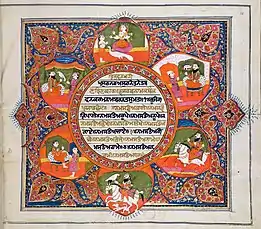Hikaaitaan
Hikaaitaan or Hikāyatān (Punjabi: ਹਿਕਾਇਤਾਂ) is a title given to the semi-legendary set of 11 tales (hikayat), composed in the Gurmukhi Persian language (with a few words in the Majha dialect),[1] whose authorship is historically and traditionally attributed to Guru Gobind Singh. It is the last composition of the second scripture of Sikhs, Dasam Granth, and is believed to be appended to Zafarnamah—the letter to Mughal king Aurangzeb.
| Part of a series on |
| Dasam Granth |
|---|
 |
| Dasam Granth - (ਦਸਮ ਗ੍ਰੰਥ ਸਾਹਿਬ) |
| Banis |
|
| Other Related Banis |
|
| Various aspects |
| Idolatry Prohibition |
Historically and traditionally, the set of tales was written at Dina, Punjab, in 1704 AD.[2] In total, there are 11 tales—composed of 752 couplets; however, historically, the first hikayat is Zafarnama, which brings the count to 12. Each tale begins with praise of the Almighty. This composition is present in all old manuscripts, including those of Mani Singh, Motibagh, Sangrur, and Patna manuscripts.[3]
Authorship and relation with Zafarnama
As per early Sikh historical resources, Parchi Patshahi Dasvin (Sevadas, 1741)[4] and Gurbilas Patshahi 10 (Kuir Singh, 1751),[5] hikayats were composed by Guru Gobind Singh at Dina Kangar, Punjab and is part of Zafarnamah which was sent along with Zafarnama. Koer Singh believes that Guru Gobind Singh had written 12 hikayats in Zafarnama.[6] In Sakhi 13, Sevadas mentioned that Guru Gobind Singh had written fables of many kings and also mentioned his own history in Zafarnama.[7]
The historical and traditional view is that all the Hikayats was composed by Guru Gobind Singh himself, to make Aurangzeb realize his folly in breaking oath of Quran, improve his decision-making ability on the basis of facts, and to check the activities of different departments of his government. Pundit Narain Singh, who did an exogenesis of Dasam Granth, also had the same view. Many of these tales are the Persian translations of the narratives in Charitropakhyan, which serves as an additional proof of single authorship of both compositions.[8]
A few modern scholars claim that hikayats are not part of Zafarnama, as in their viewpoint these tales do not show any relation with the letter.[9] and was written by court poets.[10]
Tales
The following are tales and brief descriptions of the same:
- Tale of Guru Gobind Singh and King Aurangzeb: An autobiography of Guru Gobind Singh that includes philosophical, political, and satirical aspects.
- Tale of King Daleep and His Four Sons
- Tale of King of China: Explaining the qualities of a perfect ruler, with political and philosophical aspects
- Tale of King Subhat Singh and Bachitarmati
- Tale of King Sabal Singh
- Tale of King Chakrawati and Qazi Daughter
- Tale of King Darab and Queen of Rome
- Tale of Princess of Bilistan
- Tale of King of France and His Wife
- Tale of King Mayindra and Advisor's Daughter
- Tale of King Sher Shah and Tycoon's Daughter
- Tale of Pathan Raheem Khan and His Wife: Horror, slasher and weird story, where woman kills her lover, cooks him and serves him to her husband
Relationship with Sri Charitropakhyan
The following is a list of Hikayats which are similar to narratives in Charitropakhyan. In fact, many of these are the Persian translations of the narratives in Charitropakhyan.
- Hikayat 4 and Charitra 52
- Hikayat 5 and Charitra 267
- Hikayat 8 and Charitra 118
- Hikayat 9 and Charitra 290
- Hikayat 11 and Charitra 246
The similarity of narratives in Hikayats and Charitropakhyan serves as an additional proof of single authorship.[8]
References
- Page 93, The A to Z of Sikhism, W. H. McLeod
- Sri Dasam Granth Sahib:Q & A, Kamalroop Singh
- Sikh Religion, Culture and Ethnicity, C. Shackle, Arvind-Pal Singh Mandair, Gurharpal Singh
- "Parchi Patshahi Dasvin, Sevadas". Archived from the original on 2013-12-27. Retrieved 2013-01-06.
- Gurbilas Patshahi 10, Kuir Singh
- ਫ਼ਰਨਾਮ ਹੈ ਸਭ ਜਗ ਜਾਨੈ। ਲਿਖੀ ਹਿਕਾਯਤ ਦਵਾਦਸ ਤਾ ਮੈ। (ਪੰਨਾ 199), Gurbilas Patshahi 10, Koer Singh
- ਸਾਖੀ ੧੩ : ਅਗੇ ਸਾਖੀ ਦਸਵੇਂ ਮਹਲ ਕੀ ਤੁਰੀਆਂ: ........ ਓਹ ਖਤ ਮੇ ਕੇਤੇ ਫਰਦ ਲੀਖੇ | ਕੇਤੀਆ ਰੁਬਾਈਆਂ , ਕੇਤੀਆ ਬਾਦਸ਼ਾਹ ਕੀਆਂ ਸਾਖੀਆਂ ਲਿਖੀਆਂ | ਅਰੁ ਕਛੁ ਆਪਣੀ ਹਕੀਕਤ ਭੀ ਲਿਖੀ | ........., Sakhi 134, Parchi Sevadas, Piara Singh Padam
- sikhisearch.com
- Dasam Granth,Dr. S.S. Kapoor
- Page 141, A book of Sikh studies, Gobind Singh Mansukhani